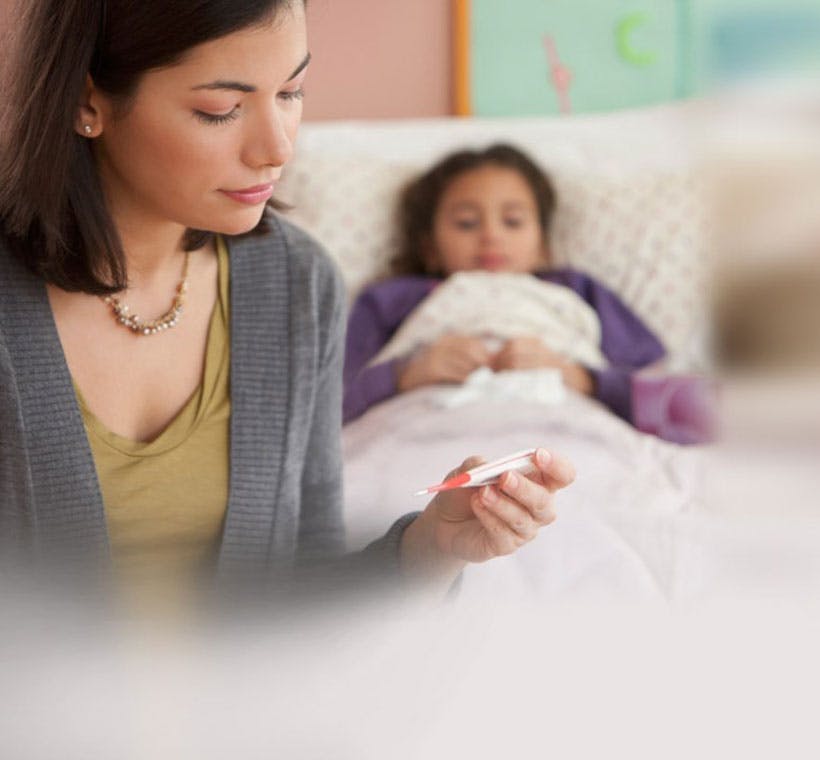Managing Fever

Managing Fever
Most fevers are mild1 and can be easily managed. However, it’s easy to worry when your child is distressed and uncomfortable.
Temperature’s rising
Fevers are extremely common in children, with between 20-40% suffering a raised temperature each year.2 The body’s ‘normal’ temperature, is around 98.6°F, plus or minus around one degree Fahrenheit (F).3
If your child’s temperature is over 99.5°F/37.5°Celcius (C)1 or 100.4°F/38°C when taken rectally,3 then they are considered to have a fever.
A fever is your body’s way of fighting back against infection and can often be a good sign. 4 Generally, fevers happen when your child’s immune system is fighting infections such as colds, coughs and ear infections.4 At the first sign of attack, the body’s defenses launch infection-fighting chemicals into the blood.4 These chemicals also affect the body’s thermostat, which is located in the brain and called the hypothalamus.5
While this is a positive thing, the downside of fever is that your child may feel uncomfortable and distressed.4
Temperature taking
There are a number of different ways you can check if your child has a fever:
- Oral. The thermometer is inserted under the tongue, the mouth is closed and a reading is taken.2
- Rectal. The thermometer is gently inserted into the rectum (child’s bottom) and a reading is taken.2
- Armpit. The thermometer is placed under the armpit and the arm is held against the side of the body while a reading is taken.
- Ear. A digital thermometer is inserted into the ear and a reading is taken.
Always ensure that you read the instructions provided with the thermometer before you use it.
There are different types of thermometer you can use:
- Digital. These thermometers are quick and accurate and can be used for taking temperatures orally, rectally and under the armpit.
- Ear. These digital thermometers are inserted into the ear and can only be used to take ear temperatures. They can be more expensive than other types of thermometer.1
- Strip. These are placed against your child’s forehead, and show the temperature of the skin, but not the body. They are not very accurate.1
- Glass. There are two types of glass thermometer; those that contain a colored alcohol to measure the temperature, or the more old-fashioned type which contain mercury. The use of mercury glass thermometers is not recommended, as mercury can be highly poisonous.1
Temperature reducing
If your child has a fever, but is fine in every other way, then you may not need to do anything, aside from making sure they have plenty of cool, non-carbonated drinks to keep their fluid levels up.1, 6 When a baby or child is breastfed, the most appropriate fluid is breast milk.
If they seem unwell or distressed then you can consider children’s pain relievers, such as paracetamol or ibuprofen.2 These have been shown to be equally effective in reducing fever, even high fevers.7,8
Other things that may help include:
- Removing some clothing to help cool your child down1
- Keeping the room temperature comfortable by turning down the heat or opening windows. Take care not to make it too cold – around 65ºF is about right.1
- Tepid sponging, which can reduce fever by a couple of degrees in less than an hour.6 To sponge your child, sit them in a tepid (lukewarm) bath and spread water gently over their body with a washcloth or sponge.6
When to call a doctor
For most children, fever is a mild problem, but there are some children who may need to see a doctor. More information about warning signs of when to contact a doctor if your child has a fever can be found in Fever in Children: When to Call a Doctor.
References
- UK NHS. Birth to Five. Available at http://www.nhs.uk/Planners/birthtofive/Pages/Treatinghightemp.aspx
- UK National Institute for Health and Clinical Excellence. Guideline 47: Feverish illness in children. Assessment and initial management in children younger than 5 years. May 2007.
- American Academy of Pediatrics. Fever without fear. Available at: http://www.healthychildren.org/English/health-issues/conditions/fever/Pages/Fever-Without-Fear.aspx
- American Academy of Pediatrics. Fever and your baby. Available at: http://www.healthychildren.org/English/health-issues/conditions/fever/pages/Fever-and-Your-Baby.aspx
- Wolff SM, Dinarello CA. The Jeremiah Metzger Lecture: The pathogenesis of fever in human subjects. Trans Am Clin Climatol Assoc, 1980; 91: 159-166.
- American Academy of Pediatrics. Treating a fever without medicines. Available at http://www.healthychildren.org/English/health-issues/conditions/fever/pages/Treating-a-Fever-Without-Medicine.aspx
- Walson PD, Galletta G, Chomilo F et al. Comparison of multidose ibuprofen and acetaminophen therapy in febrile children. AJDC 1992; 142: 626-632.
- Autret-Leca E, Gibb IA, Goulder MA. Ibuprofen versus paracetamol in pediatric fever: objective and subjective findings from a randomized, blinded study. Curr Med Res Opin 2007; 23: 2205-2211.




